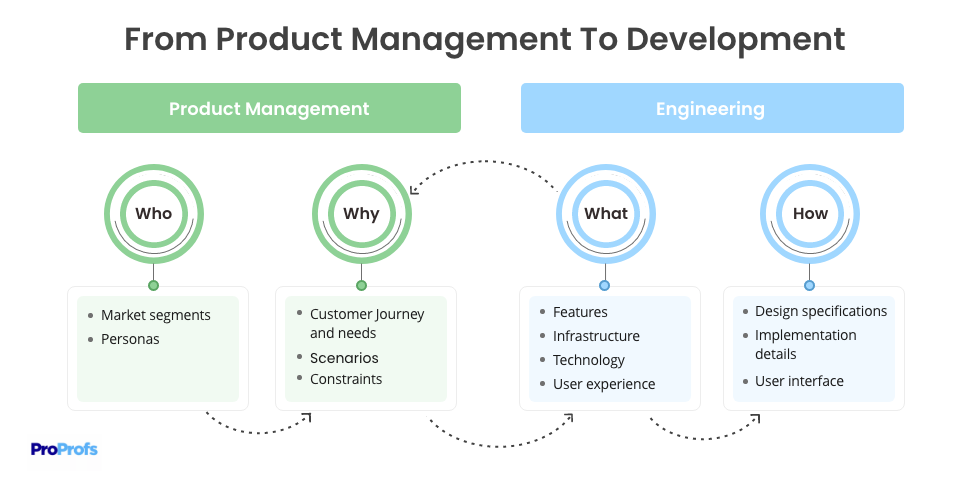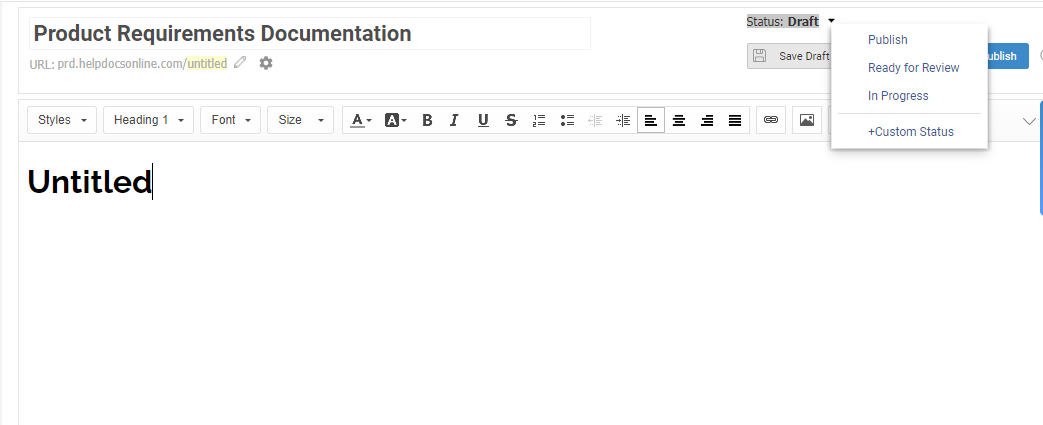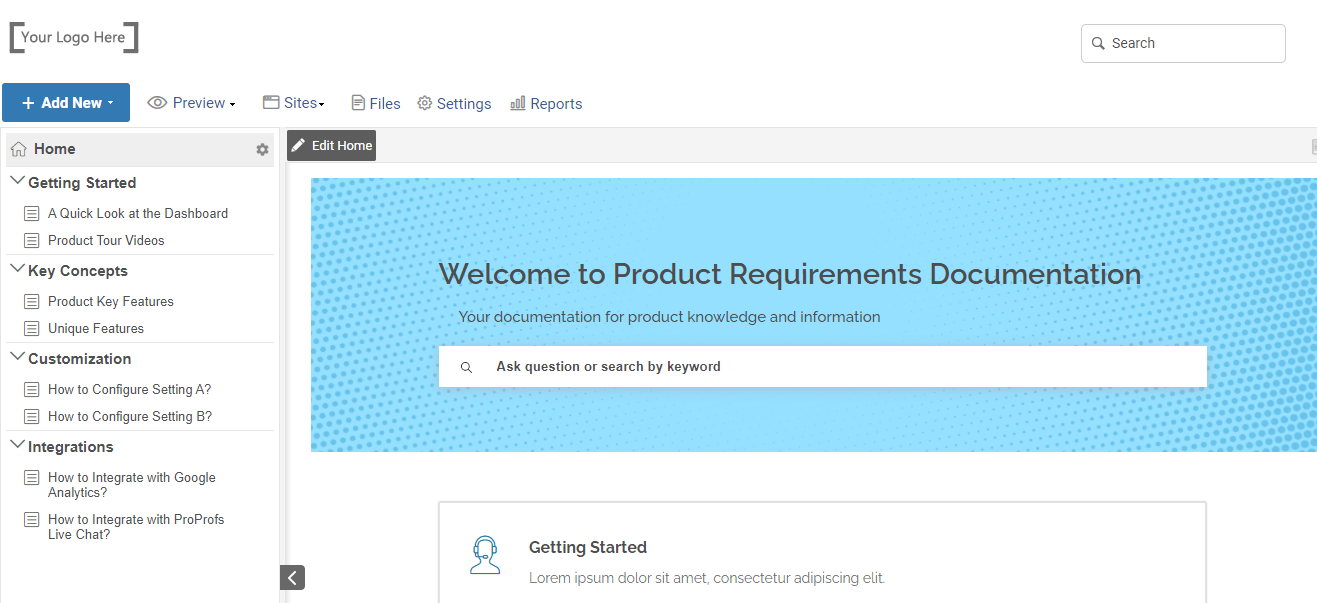
The market is replete with products of all kinds, each claiming to be better than the other.
In such a scenario, where competition is intense and winning customers is hard, how do you create a unique product that gives you a definite edge over what your competitors are selling?
The answer lies in doing the little things right.
You might have a never-before-heard product idea but the journey to take it to the execution stage ultimately decides whether your product will be a success or a failure.
A product requirements document is a crucial part of this journey. It acts as a roadmap guiding your product team through the entire process of product development from start to finish.
Explore the essentials of this document and discover the steps that can help you create product requirements documentation for a successful product launch in this blog.
| Related blog: How to Create Online Documentation? |
What is a Product Requirements Document (PRD)?
A product requirements document outlines the ultimate goal the product should achieve and the problems it is designed to solve. Built using product documentation software, this document is a key part of the product’s planning stage and is also the most referenced document that keeps everyone in your team connected and aligned.
From what the product is, how it should be designed, and what success it will bring to those who use it, the document provides all essential information guiding the product to its final implementation.
Why is a PRD Essential for Your Business?
When you go to a new city or visit a new place where you haven’t been before, do you do a background check online before beginning the journey?
Yes, we all do. Looking for travel guides online helps in getting familiar with the place before actually getting there. This makes our experience more enjoyable and less fussy.
The same concept applies here. Before finally launching the product, it’s important that you have the right path to follow. A product requirements document provides you with that path. The purpose of a product requirements document is to guide all stakeholders involved in the process from the very beginning, keeping them on the same page and promising a stellar product in the end. It keeps the vision clear, explaining what needs to be built and how the process should go.
From features and use cases to product goal, purpose, scope, and budget, the document lists down everything so that the stakeholders can refer to it whenever they are stuck in the development process.
Without a product requirements document, the journey to achieving product success is a bumpy one, full of confusion and chaos.
Key Components of a Product Requirements Document
A typical product requirements document consists of six essential elements, such as:
1. Product Goal
This defines the product’s primary purpose – why it is important, the problems it solves, and the value it provides to end-users. It also shows how the product aligns with your overall company’s goals and objectives.
2. Product Specifics
PRD gives a detailed description of the essential features and functions of a product. It shows how each feature should work to help end-users accomplish the desired goals.
3. Product Release Criteria
PRD also provides fixed criteria for successful product release. The criteria are based on various aspects such as ease of use, reliability, functionality, and performance.
4. Timeline
Setting a rough estimate of when the product will be released helps stakeholders plan and execute the process better. PRD shows the release timeline, empowering everyone in the team to accommodate changes while still hitting the target date.
5. Product Design
PRD also draws light on how the product should look like. It provides a wireframe of the design to give everyone involved an idea of how the final output should turn out.
6. Constraints
Constraints are the areas where product implementation might face difficulties. These should be documented to keep all stakeholders informed of all the things that can pose problems in the process.

The product requirements documentation structure should incorporate all these components in a way that it doesn’t feel overwhelming to read and at the same time gives your product team a clear roadmap to follow.
Read More: Best Project Documentation Software & Tools in 2024
Major Challenges of Writing a Product Requirements Document
Creating a product requirements documentation is not a walk in the park. Regardless of how well-prepared you are, there are certain challenges that you have to deal with during the process. Some of these are:
1. Customer-Aligned Product
What might seem obvious and basic to you might be confusing and difficult to understand for end-users. As product creators, this is an important element that’s often missed while building product requirements documentation.
Test the product regularly with end-users as it develops, and identify how easy or difficult it is to use. Find how customers are using the product and whether or not they are receiving real value out of it. Use this knowledge to modify your product requirements documentation so that the ultimate product incorporates these changes.
2. Too Many Features
If you are of the opinion that filing a product with features is the way to a customer’s heart, think again. Feature overload is a key challenge facing writers while creating product requirements documentation.
Adding a lot of features just to woo end users can be counterproductive. Understand that customers are happier when they get more value out of fewer features. More features mean more confusion and less clarity. Add features that are easy to find and use and those that provide real value to customers.
Read more: Tips to Creating a Software Documentation
3. Too Less & Too Much
Too much and too little detail in a PRD is the root cause of confusion. Giving engineers full control of the product is good, but some level of specificity is ideal to have in the document. Gaps in the information provided or too many details in the document can sway engineers from the right path, testing their patience and resulting in more chaos than clarity. The result – a product that’s far away from your expectations.
While creating online product requirements documentation, remember to talk about all necessary information, product-related problems and their solutions, associated risks, and much more to prevent team members from making wrong assumptions.
4. Ad-Hoc Requirements
This is a common challenge you might encounter while creating your product requirements documentation.
It is possible for your sales, marketing, or engineering teams to raise product requirements based on a new technology that is taking the market by storm and new feature demands made by customers themselves. Such situations can feel overwhelming to product managers and document creators, changing the original plan to build the product in a certain way.
Such ad-hoc requirements must be handled with care. It’s not necessary to accept all demands raised by different teams if they negatively impact the final solution. Think of what customers want, what value they need, and incorporate only those changes that fit well with your product release timelines.
Read More: Best Online Documentation Software and Tools for 2024
Best Practices for Creating a Winning Product Requirements Document
A product requirements document is a compass showing product developers what’s right and what’s wrong and guiding them at every step towards the desired solution. Being a critical document that shapes the product development journey, it’s essential to put some effort and time into the process.
Follow these product requirements documentation best practices and get started with your documentation journey.
1. Identify the Problem
Why are you building this product?
What customer problems will the product solve?
Ask yourself these questions before taking your first steps towards creating the product requirements documentation. Talk to your customers. Understand what problems they are facing and find out how your product can solve them. A little background work, in the beginning, goes a long way in building the right product that provides customers the value they are seeking.
Brainstorm with your marketing, sales, and support team about the problems bothering customers and find ways to solve them. The insights that customer-facing teams can give you are difficult to find somewhere else. Consult with these teams and study deeply about the problem.
This will give you the confidence to build a unique product aligned with customer needs and drive efforts in the right direction.
2. Set Product Goals
Once you know the problem, zeroing in on a product goal is easier.
Start your documentation by writing about the customer needs your product will be meeting. The team working on the product should know why they are creating the product and what goals will be driving their efforts. Besides, you can also discuss the problems the product will be solving, the target audience, and the different use cases of the product in the documentation.
A clear context and specific goals help in channelizing your team’s efforts in the right direction, successfully turning your product vision into reality.
3. Identify Your Customers & Their Goals
Once you know the product inside out, the next step is to identify and analyze the customers who will be using it and what goals they need to accomplish.
Identify and define your customers in the document by creating user profiles based on gender, age, the field of work, purchase behavior, attitude, any previous history with your organization, and other such data.
Defining product users is a huge help in understanding what they would like and what they won’t, which features or product developments they would take positively and how they would be using your product. Ensure that the user profile you create is a genuine representation of your customers, as it will help your teams shape and polish the product in a way that best fits user requirements.
What next? Identify the objectives customers want to fulfill with your product. Talk to your potential customers, create a survey and take their feedback to craft solutions tailored to their exact needs.
4. Set the Release Criteria
The criteria giving the green signal of the final product launch should be clearly mentioned in the product requirements documentation. Ideally, the release criteria should focus on key areas such as ease of use, performance, reliability, and functionality.
Ease of use focuses on how intuitive and hassle-free the product is for users. Functionality outlines the mandatory functions required to launch the product, and performance determines how well the product should perform in order to be finally released. Reliability checks how reliable it is for end-users and how well it deals with failures.
Discussing the release criteria is a vital step in creating a product requirements documentation, and therefore it should be taken up early on in the process. While setting the criteria and formalizing it in the PRD, ensure that you have the consensus of all the stakeholders involved so that no one gets surprised later.
5. Mention the Assumptions & Constraints
Making assumptions and facing constraints in the product creation process is natural. You simply can’t avoid these. But what is in your power is to document the assumptions and constraints to prevent the chances of grave mistakes.
While developing a product, assumptions related to its users, technicalities, and goals are likely to be made. It’s crucial to document these assumptions as these might impact the decisions you make during the product development process.
Similarly, certain challenges are likely to occur, which might delay the process further. You can avoid that by writing down these constraints in your product requirements documentation.
For example, if the constraints are related to a product’s budget or some specific features, recording them clearly in the PRD gives all stakeholders a clear view of what might affect the product development pace and, eventually, the release timeline. This will keep them better prepared from the very beginning.
6. Set a Practical Timeline
A rough estimate of the time required to launch the product keeps all stakeholders in the right frame of mind from the start. They will know the speed they need to work with in order to meet the release date, which will increase the chances of your product releasing on time.
As the process is full of unpredictable changes and challenges, it is crucial to keep these into account while setting the timeline. Establish a practical timeline that gives your team the flexibility to incorporate necessary changes while still hitting the release date.
Another important thing is to analyze which product documentation requirements to prioritize first and which ones can be taken up later. If prioritization is not done right, your team might be inclined to take up the easiest requirements first, leaving less time for the difficult and more important changes.
In your documentation, mention the criteria to prioritize requirements to help your team implement changes without affecting the product launch timeline.
7. Get the Document Reviewed by Key Stakeholders
For product developers, testers and managers, it’s vital to have access to the most accurate and latest product information. Obsolete content can create gaps in the product development process, leading to defects and inaccuracies in the final product.
While creating the product requirements document, remember to get each article reviewed by key stakeholders. Let them bring their subject matter expertise to the table and give their valuable contribution towards the content creation and review process. Since stakeholders know your product in and out, they can give the best possible insights and conduct a 360° review before the document is published online.
This means everyone in your product development team will have access to the latest product information they can use confidently without thinking twice.
Modern documentation tools, such as ProProfs Knowledge Base, come with a full-fledged content review system where writers can seek reviews and insights from anyone in the team, simply by setting status for every article they work on.

8. Document the KPIs to Measure Product Success
Write down the key performance indicators (KPIs) to help stakeholders measure the success of the product once it is released. KPIs act as the benchmark to analyze a product’s effectiveness for customers.
While setting benchmarks, remember that they should be practical and achievable. If you set a benchmark that’s way beyond your product’s capabilities, getting a transparent picture of your product’s true performance is highly unlikely.
Some of the KPIs you can describe in the document are – customer lifetime value, customer retention rate, monthly sales, churn rate, customer satisfaction score, and other such metrics.
Define these metrics and help stakeholders gain a holistic understanding of where your product really stands in terms of performance, customer satisfaction, and effectiveness.
Product Requirements Documentation Templates
If you want to get started with a PRD right away, choose a software documentation tool that provides product requirements documentation templates, as that would make your job much easier and manageable.
Since a PRD is a comprehensive document full of detailed articles on a variety of product-related topics, where to begin writing can be a daunting task for the product team. PRD templates are designed to give you the right head start and get your documentation ready with zero hassles.
ProProfs Knowledge Base offers beautifully designed product documentation templates that you can use and adapt to your requirements. They are super simple to use, fully customizable, and take half the pressure off your team’s shoulders.

Create Your PRD With ProProfs Knowledge Base
It’s now time to put all the theories discussed above into practice. By now, you already know what a product requirements documentation is, what it does, and the best practices to get this documentation ready. Let’s rewind it a bit.
While creating a product requirements documentation, start by evaluating customer problems, identifying and understanding your target users. Set product goals, release criteria, and a practical timeline, to make your product development process a success.
ProProfs Knowledge Base software can provide you with the much-needed starting point for building your documentation. From content authoring and designing to managing and publishing the document, the tool is competent to handle all your documentation needs with ease.
It helps you centralize all product information on a cloud-based platform where your product team can easily collaborate, share, and access knowledge. No more wasting time hunting for information tucked in scattered files and folders, as everything your team needs is right in front of them.
FREE. All Features. FOREVER!
Try our Forever FREE account with all premium features!







